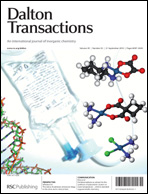The non-classical KP6Mo18O73 heteropolyanion has been studied by the density functional theory (DFT) method, and the calculated geometry compares well with the experimental one. In fully oxidized [KP6Mo18O73]7− state, the dxy-orbitals centered at eight “belt” Mo sites in the lower part of the “basket” are the major contributors to the LUMO and LUMO+1, while the LUMO+2 orbital is mostly focused on the two polar parts. In contrast, the HOMOs indicates that the coordination of the KP6Mo18 heteropolyanion to metal ions favorably occurs at the oxygen atoms from four external phosphates and two molybdates of the handle of the “basket”. Compared with Wells–Dawson [P2Mo18O62]6−, the HOMO–LUMO gap in fully oxidized [KP6Mo18O73]7− is much smaller, indicating much easier reduction that is consistent with the cyclic voltammogram. Both frontier orbitals and Mulliken analysis indicate that two of three blue electrons in [KP6Mo18O73]10− (KP6Mo18-3e) have spin alpha while third blue electron has spin beta, in agreement with magnetic data. The four-copper complex of the non-classical KP6Mo18-3e heteropolyanion has been synthesized and structurally characterized; its structure supports the theoretical results such as reactivity and basicity of external oxygen sites.

You have access to this article
 Please wait while we load your content...
Something went wrong. Try again?
Please wait while we load your content...
Something went wrong. Try again?


 Please wait while we load your content...
Please wait while we load your content...